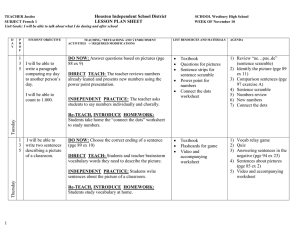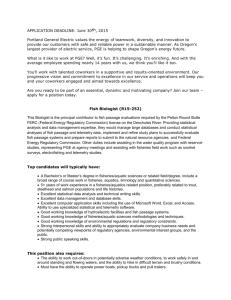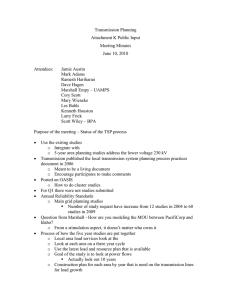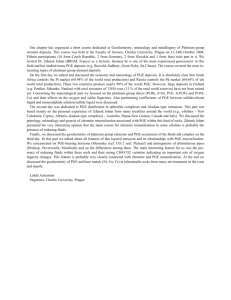Section 3 Intro.fm - Portland General Electric
advertisement
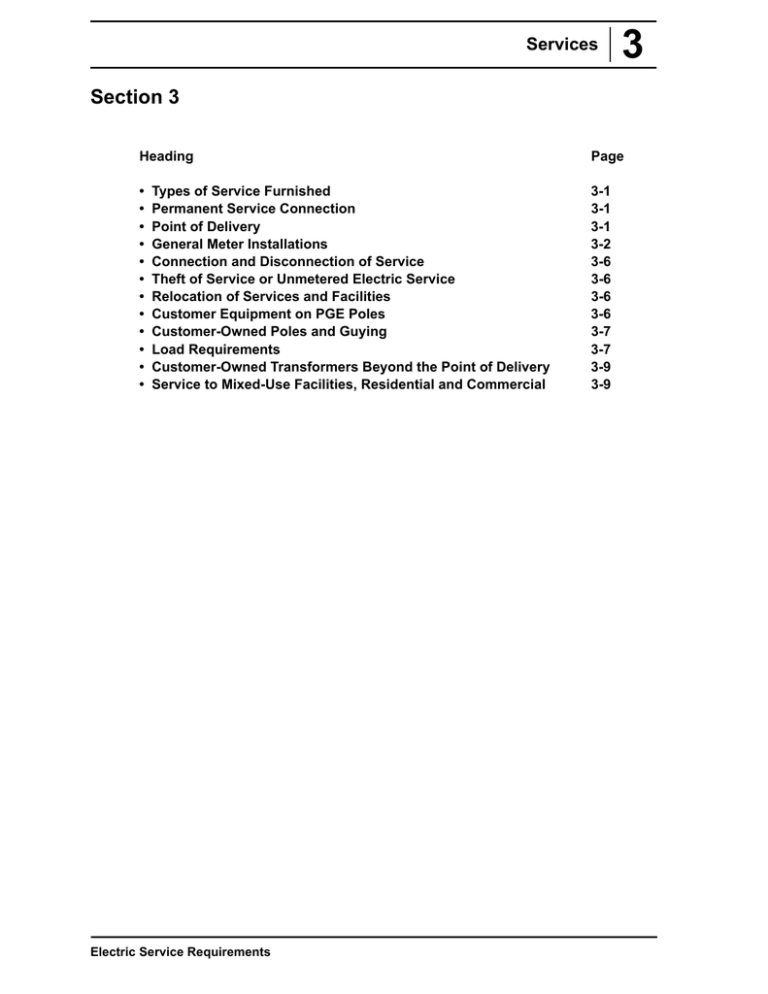
Services 3 Section 3 Heading Page • • • • • • • • • • • • 3-1 3-1 3-1 3-2 3-6 3-6 3-6 3-6 3-7 3-7 3-9 3-9 Types of Service Furnished Permanent Service Connection Point of Delivery General Meter Installations Connection and Disconnection of Service Theft of Service or Unmetered Electric Service Relocation of Services and Facilities Customer Equipment on PGE Poles Customer-Owned Poles and Guying Load Requirements Customer-Owned Transformers Beyond the Point of Delivery Service to Mixed-Use Facilities, Residential and Commercial Electric Service Requirements Services 3 3 Services 3.1 Types of Service Furnished Available electric service is 60 hertz, alternating current, single-phase or three-phase. See Section 3.10, Load Requirements. The nominal secondary voltages are provided below. 3.1.1 Underground Service The following underground service may be provided: • Single-phase, 120/240-volt, three-wire, grounded • Single-phase, 240/480-volt, three-wire, grounded • Three-phase, 208Y/120-volt, four-wire, grounded, wye • Three-phase, 480Y/277-volt, four-wire, grounded, wye • Three-phase, 240/120-volt, four-wire, grounded, delta • Three-phase, 480/240-volt, four-wire, grounded, delta 3.1.2 Overhead Service The following overhead service may be provided: • Single-phase, 120/240-volt, three-wire, grounded • Single-phase, 240/480-volt, three-wire, grounded • Three-phase, 208Y/120-volt, four-wire, grounded, wye • Three-phase, 240/120-volt, four-wire, grounded, delta • Three-phase, 480Y/277-volt, four-wire, grounded, wye • Three-phase, 480/240-volt, four-wire, grounded, open-delta If other service voltages are required, the Customer must request, and PGE must approve, these voltages before services can be provided. If primary voltage service is requested, see Section 3.4.7 and contact PGE. 3.2 Permanent Service Connection Only authorized PGE employees can make the permanent connection or disconnection of PGE electric service. Services must not be jumpered prior to local inspection and permanent connection by PGE. Services must not be energized without NEC-approved covers properly secured. See Section 2.4, Emergency Connects or Reconnects. 3.3 Point of Delivery The point of delivery for commercial and industrial Customers refers to the location where the PGE circuit connects to the Customer’s system. The point Electric Service Requirements 3-1 3 Services of delivery must be on the outside of the building. Only with prior written approval by PGE may the point of delivery be located in a dedicated electrical room. PGE will only install service connections to the Customer’s meter equipment at the main or entry-floor level. The point of delivery for residential Customers must be ten-feet maximum from the corner of the house closest to PGE lines. The Customer must contact PGE to determine an appropriate location of the Customer’s meter equipment. See Section 5.3, PGE Electrical Equipment Room requirements and the Electrical Room Checklist. NOTE: For residential overhead services, the house siding must be installed before service will be provided. 3.4 General Meter Installations The PGE tariff and rate schedules require the delivery of each class and type of electrical service through one meter to one Customer at one location. NOTE: Except where a separate service is used to minimize voltage fluctuations on secondary voltage circuits (Section 1.10, Time-of-Use Metering), meters must be accessible during normal work hours for meter reading and testing. Meter location is subject to PGE approval. Metering equipment, such as a meter base or CT cabinet, must not be installed on the drive-through service entrance side of a commercial building. Existing drive-through locations where PGE equipment is installed on the drive-through service entrance side are subject to temporary closure of the drive-through lane(s) when necessary for PGE to access metering equipment. Customers are not authorized to relocate any meter belonging to PGE or interfere in any way with the meter or its connection. The person responsible for the electrical work must contact PGE for any work that involves relocation, rewire, or new installation of a meter. Removal of the meter from some types of meter sockets does not deenergize the service and may result in death or serious personal injury when working on an energized service. Test the service with a voltmeter or other appropriate instrument to verify it is de-energized before performing any electrical work. The Customer must promptly notify PGE upon completion of repairs or modifications so PGE can inspect, install, and seal the meter. See Section 3.4.2, Sealing Provisions and Section 1.6.1, Safety. 3-2 Electric Service Requirements Services 3 3.4.1 Acceptable Meter Sockets Acceptable meter sockets are manufactured in accordance with the current EUSERC requirements, standards for Safety Meter Sockets, ANSI C12, and UL/ANSI 414. The Customer must provide and install the meter socket complete with terminal lugs, meter jaws, manual link bypasses or safety sockets (when required), and sealing means for all sections. Consult PGE for meter socket types. NOTE: Ringless-style meter sockets are not approved. When a meter socket is installed in a switchgear, it must be wired by the switchgear manufacturer per EUSERC Drawing 300, Meter Sockets, General. The load side of the meter must be wired to the breaker or disconnect position. Service to a switchgear that has been wired or altered by the Customer will be turned down. 3.4.2 Sealing Provisions PGE uses seals placed on meter rings and associated service equipment to prevent injury and/or tampering. Sealing provisions for associated service equipment must use a stud/wing nut assembly or a clip suitable for use with a seal. All cabinets and gutters containing unmetered conductors—other than mainline switches required by applicable codes—must have sealing provisions. Removable sections of conduit may only be installed when approved by PGE and must be sealed by PGE. Unmetered conductors passing through a service disconnect compartment for a mobile home service pedestal must be in conduit and arrangements must be made for sealing. 3.4.3 Mounting of Meter Sockets Verify that clearances for meter sockets meet the requirements shown in Figure 5-2 and Figure 5-3. Plumb sockets in all directions and securely mount them to a rigid surface. Securely fasten conductors to their respective terminals and arrange them in a manner that will not interfere with the installation of PGE conductors, the meter or cover, or with the operation of manual link bypasses. If the meter cabinet is to be recessed in the wall, install a flush-type box or meter cabinet designed specifically for that purpose so the face of the meter cabinet projects outward beyond the building surface as approved by PGE. PGE requires 48 inches of clear working space in front of live parts and 78 inches of clear headroom. Do not install a barrier post that is within 48 inches of the front of the meter panel when a meter is removed and energized parts are exposed. For information on barrier posts, see Section 6.4.6 or contact a PGE Service Coordinator. Electric Service Requirements 3-3 3 Services Locate meter sockets and other metering equipment at least 36 inches horizontally from a gas meter, gas valve, or nearest gas component (outlet elbow or flange) of the meter set. See Figure 5-4, Figure 5-11, and Figure 5-12. The unmetered service conductor and the metered service conductor will not be run in the same conduit, raceway, or gutter. This does not apply to minor repair jobs if coordinated with PGE before repair. Be sure adequate protection exists for meters subject to physical damage. Barrier posts are required when metering equipment is exposed to vehicle traffic. See Figure 6-5. 3.4.4 Access to the Meter Socket The meter socket must be mounted in such a way as to not hinder removing the meter and/or cover from the base. The meter base panel, ring, and/or lid must not be sealed or obstructed in any way other than those methods allowed under the NEC and PGE Electric Service Requirements. Any hindrance—including but not limited to siding, caulking, enclosures, and landscaping—must be removed by the property owner in order to allow unrestricted access to the meter base. 3.4.5 Corrosive Areas Meter sockets and other metering cabinets installed in highly corrosive areas, such as dairy farms, fertilizer or chemical plants, must be constructed of stainless steel. 3.4.6 Meter Socket Adapters Customer-owned meter socket adapters or meter collars used for purposes such as providing a power source are not allowed on PGE services. 3.4.7 Primary Voltage Service High-voltage instrument transformers and transformer-rated meters are required for Customers taking service at primary voltage under provisions of the PGE tariff. To establish a mutually satisfactory location for the service point and metering details, the Customer must consult PGE before construction begins. PGE will not accept some transformer configurations because of disruptive operating characteristics. The Customer must submit specifications for protective devices and transformers, including core types and winding configurations with associated wiring, for written approval by PGE. Contact PGE for details and limitations before installation. 3-4 Electric Service Requirements Services 3 PGE will provide primary voltage delivery to qualified Customers directly—without transformation—from the high-voltage or primary distribution system (standard for the location in which service is requested) if the following conditions apply: • The service at primary voltage will not—in the judgment of PGE— adversely affect the operation of the PGE distribution system or service to other Customers. • The service supplied is distributed in a safe and reliable manner. • The Customer provides switching devices with appropriate overcurrent protection to isolate the utility system from disturbance on the Customer-owned primary facility. • The Customer is responsible for the operation and maintenance of all Customer-owned equipment. PGE does not provide replacement parts for Customer-owned equipment. PGE will install disconnecting means at, or near, the service point to separate the Customer’s system from the PGE system for PGE use only. This disconnecting means may include overcurrent isolation. This equipment is in addition to any disconnects or switches provided by the Customer on Customer facilities. 3.4.7.1 Switchgear Enclosure for Primary Metering Prior to construction, the Customer must consult with PGE regarding primary services greater than 600 volts. Customers must meet the requirements of EUSERC Section 400 when switchgear enclosures are required to meter mediumvoltage delivery services. Ten feet of clear workspace is required in front of access doors. The Customer must submit approval drawings of the metering equipment to PGE prior to fabrication. Such drawings must indicate the company name, the job address, the contact address, and the phone number of the manufacturer’s representative. The Customer must provide and install: • all necessary hardware per EUSERC Section 400; • a clear workspace 78-inches high, 48-inches deep, and as wide as the PGE metering equipment; • a concrete mounting vault (with a minimum 4-inch thick concrete pad) for the switchgear metering enclosure. PGE will provide: Electric Service Requirements • the meter; • a meter test switch; 3-5 3 Services • instrument current and voltage transformers and secondary metering wiring. NOTE: The Customer must consult PGE for specifications on instrument transformers, the meter test switch, and secondary wiring of instrument transformers prior to ordering the meter enclosure. Enclosure drawings with a site plan and electrical room detail must be provided to PGE for approval prior to installation. 3.5 Connection and Disconnection of Service Connection and disconnection of any service will be done by PGE. The Customer will be billed a charge according to the fee schedule in effect. A permit and inspection by the local code enforcing agency, and approval by PGE, is required before reconnection for the following: • All services that have been disconnected longer than six months. • Any service that has had Customer electrical equipment modified in any way. All work must be scheduled with PGE for connection and disconnection of service. No permit or inspection is required if an overhead drop is disconnected temporarily to allow felling of a tree or to provide safe working clearances for roofing, painting, or siding. For emergency connects or reconnects, see Section 2.4. 3.6 Theft of Service or Unmetered Electric Service Any unauthorized connections or wiring attached ahead of the meter, allowing for unmetered electric service, whether intentional or unintentional, should be immediately reported to the PGE Energy Recovery Unit. All calls will be treated in the strictest confidence and callers will remain anonymous. The Energy Theft Hotline is 1-800-962-8184. The hotline is available 24 hours a day, 7 days a week. 3.7 Relocation of Services and Facilities A fee may be charged if the Customer requests or requires relocation of existing PGE facilities. 3.8 Customer Equipment on PGE Poles Customer-owned metering equipment, switching devices, conduits, conductors, or luminaires must not be mounted on a PGE pole. 3-6 Electric Service Requirements Services 3.9 3 Customer-Owned Poles and Guying All Customer-owned and installed poles for overhead mobile home service, farmyard, or irrigation service must meet PGE requirements for height, depth of setting, pole class, and guying. All poles must be 25-foot minimum length, set no less than 5 feet below the ground level, with gravel backfill. The size of the pole is to be Class 6 (6-inch minimum top diameter, 7-inch diameter 6 feet from the butt) or better, fulllength, commercially treated. A 6- x 6-inch treated post can be used if the post is within 25 feet of an unobstructed drivable surface. For pole lengths longer than 25 feet, consult PGE for proper setting depth. All Customer-owned poles must be guyed and anchored unless prior permission is obtained from PGE. Guys are to be a minimum 5/16-inch galvanized steel cable, having a lead-to-height ratio of 1:2. 3.10 Load Requirements 3.10.1 Single-Phase Service Equipment having a capacity of two kilowatts or more must be operated at 208 volts or higher. Customers connecting any individual motor larger than five horsepower must obtain prior approval from PGE. In addition, air conditioners and heat pumps larger than five tons require prior PGE approval. Single-phase motors larger than three horsepower may cause voltage dips objectionable to some Customers. Space or water heating must be designed and controlled so that no more than 48 amperes of load at 240 volts switches on or off at any one time. PGE limits the maximum single-phase, 120/240-volt load served through one point of termination to the capacity of a 167-kVA, singlephase transformer. PGE requires the Customer to use three-phase service in lieu of single-phase service if, in the judgment of PGE, the Customer’s connected load is excessive for single-phase service. Single-phase service over 320 amps requires current transformer metering as described in Section 10.7, Current Transformer Metering, 800-Amps Maximum. 3.10.2 Three-Phase Service Three-phase service will be provided upon request to residential and nonresidential Customers in accordance with the current PGE tariff. Electric Service Requirements 3-7 3 Services Three-phase service over 200 amps requires current transformer metering as described in Section 10.7, Current Transformer Metering, 800-Amps Maximum or Section 10.5, Customer’s Responsibility for Maintaining Switchgear. The Customer’s connection of single-phase loads to three-phase services must follow these guidelines in order to reduce the likelihood—or eliminate a common cause—of overloading or single-phasing condition that could damage the Customer’s three-phase equipment: • On a 208Y/120-volt or 480Y/277-volt three-phase service, all single-phase loads should be split evenly among the three phases. • On a 240/120-volt delta three-phase service, all single-phase loads (both 120 and 240 volt) must not utilize the high leg (wild), except resistance heating equipment, which should be balanced across all three phases. The high-leg (wild), four-wire deltas must be identified with the color orange and be on the right side of the meter base or CT cabinet. PGE will choose the voltage supplied to the Customer depending on the characteristics of the PGE distribution system in the area and the Customer’s electrical needs. PGE limits service at 208Y/120 volts to a maximum demand of 500 kVA and 480Y/277 volts to 2000 kVA. The Customer must obtain a prior agreement from PGE for service to three-phase loads larger than 500 kVA at 208Y/120 volts and 2000 kVA at 480Y/277 volts. Three-phase, 480-volt service may not be supplied where the total load to be served is less than 50 kilowatts except where the load consists of a single motor such as irrigation pumping, with nameplate rating of at least 20 horsepower, or an existing 480-volt transformer bank that has capacity for the additional load. Typically, three-phase, four-wire, closed-delta service will not be supplied from underground primary systems. New three-phase, three-wire service is not available from PGE. Conversion of an existing three-phase, three-wire service is required when: 3-8 • the Customer adds load; • electric work or repair is required in the meter base or meter socket; • the meter base or meter socket is replaced; • the service entrance conductors and/or the weatherhead is replaced. Electric Service Requirements Services 3 3.11 Customer-Owned Transformers Beyond the Point of Delivery Transformers furnished and owned by the Customer beyond the point of delivery (POD) normally used for step-up or step-down of delivery voltages (such as 208 volts stepped up to 480 volts) must conform to the types of transformers acceptable to PGE. In particular, uses of grounded wye-delta transformers installed with the grounded wye towards the POD are not allowed without protection and relaying acceptable to PGE. A fault on the grounded wye side of the Customer’s transformer may result in damage to the transformer and/or electrical equipment, improper operation of PGE protection equipment, and pose a safety hazard for Customer employees, PGE personnel, and the public. 3.12 Service to Mixed-Use Facilities, Residential and Commercial Services to mixed-use facilities, with both residential and commercial Customers, are usually complex and require that PGE be consulted for availability of service voltages, overhead or underground service options, transformer locations, and service entrance requirements before plans are completed or electrical equipment purchased. Where underground service is requested, the Customer will be required to provide the necessary space on their premises for the installation of PGE transformers and associated electrical equipment. This type of service may require a transformer pad and/or vault, or Class-A vault. Electric Service Requirements 3-9
